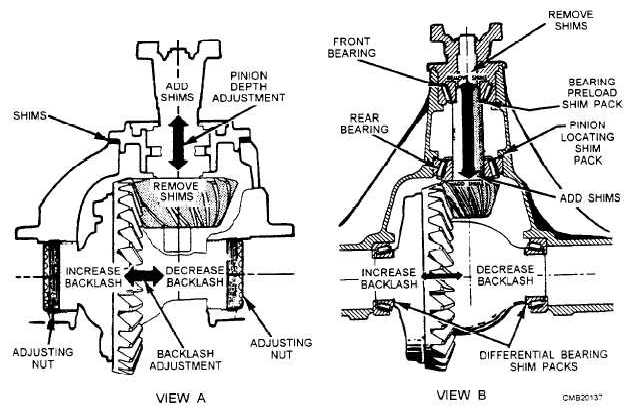Home > Construction Training Manuals > Construction Mechanic Basic Volume 2 > Differential Measurements And Adjustments
pinion, spider gears, and pinion yoke or flange should be installed exactly as they were removed. If needed. punch mark, label, or scribe these components so they can be reassembled properly.
Clean all parts carefully and inspect them closely for damage.
Rotate the pinion and case bearing by hand while checking for roughness. Inspect each bearing and race. Replace the bearing and race as a set if faulty.
If the pinion gear has a collapsible spacer (device for preloading the pinion bearings), always replace. it.
To avoid seal damage, use a seal driver. Coat the outside of the seal with a nonhardening sealer. Lubricate the inside of the seal using the proper grade of differential fluid. Make sure the seal lip faces the inside of the differential.
When tightening the pinion yoke nut, clamp the yoke in a vise or use a special holding bar.
Replace the ring and pinion gears as a set. Mesh and align the gear timing marks (painted lines or other markings) on the ring and pinion gears. This will match the proper teeth that have been lapped together at the factory.
Torque all fasteners to specifications. Refer to the service manual for torque values.
Use new gaskets and/or approved sealer.
Align all markings during reassembly. If you install the carrier caps backwards, for example, the caps can crush and damage the bearing and races. The differential could fail soon after it is returned to service.
Use the service manual for detailed directions. Differential designs and repair procedures vary. Special tools and methods are frequently required.
Differential Measurements and Adjustments
Several measurements and adjustments are made when assembling a differential. When "setting up" (measuring and adjusting) a differential. correct bearing preloads and gear clearances are extremely critical. The most important differential measurements and adjustments (fig. 5-19) include the following:
1. Pinion gear depth

Figure 5-19. - Pinion and ring gear adjustments.
Continue Reading